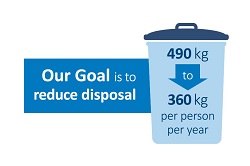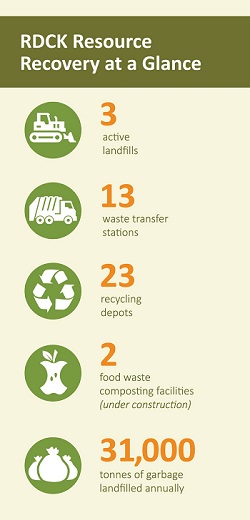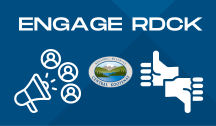Resource Recovery Plan
The RDCK is pleased to announce that the 2021 Resource Recovery Plan, created with the assistance of a multi-stakeholder advisory commitee and consultants, has been officially approved by the BC Minister of Environment and Climate Change Strategy. It replaces the previous 2010 Plan and guides recycling, composting, landfilling; and ensures sustainable waste management practices for years to come.
Solid waste management in the RDCK has evolved from burning and dumping, to our current system which meets stringent regulatory requirements and the needs of our vast region. Our waste management system has many moving parts including municipal and private collection services, recycling depots, transfer stations, and landfills, take-back programs for harder to recycle materials, plus taking care of historic or legacy disposal sites to make sure they don’t pose a risk to human or environmental health and safety.
Ideally, only when something can’t be Reused, Repurposed or Recycled is it landfilled; every solution is a step in preventing landfilled waste. Less is More.
What is a Resource Recovery Plan?
A Resource Recovery Plan (RRP), or Solid Waste Managment Plan (SWMP), is a guidance document that all BC regional districts must prepare and update every ten years. Our previous Plans have focused on improving our disposal system by closing old dumps, building transfer stations and regional landfills, and making recycling accessible to everyone. Thanks to multi-stakeholder efforts over the past few years, our current waste disposal system is significantly improved.
The new RRP contains three main strategies:
- Zero Waste - reducing what we send to the landfill
- Residual Waste - securing landfill capacity for the long-term and meeting regulatory requirements
- Financial & Administrative - supporting the actions in the RRP through responsible management
Strategy One: The Path to Zero Waste
This RRP proposes several strategies to decrease landfilling while increasing the focus on Reduce, Reuse, Recycle and Rethink, including:
- Events and campaigns that encourage waste reduction and reuse.
- Organic waste diversion to reduce greenhouse gas emissions and save landfill capacity.
- Increase participation in recycling by residents.
- Encourage our businesses and institutions to maximize their participation in recycling and waste reduction.
- Encourage and support the diversion and highest end use of construction, demolition and renovation waste.
- Encourage broad availability of extended producer responsibility (EPR) in the RDCK and support the expansion of EPR programs.
- Support the establishment of a circular economy.
- Continue education and outreach.
- Develop a regional illegal dumping strategy and support community clean ups.
What is Extended Producer Responsibility (ERP)?
EPR is a provincial policy that aims to shift responsibility for product disposal and recycling to manufacturers and away from local governments. EPR take-back programs allow consumers to return products including paint, batteries, small appliances, motor oil, smoke detectors and electronics to a depot or retailer. To find out what you can take back and where, go to RCBC.ca.

Strategy Two: Residual Waste - Managing Garbage Responsibly
How can we improve the efficiencies of our waste transfer and disposal systems while meeting regulatory requirements and ensuring environmental protection? These are some of the major activities planned:
- At the Creston Landfill: This landfill is estimated to have 30 more years of useful life. Continued use of the site is dependent on receiving approval from the Province. The RDCK hopes to acquire some additional land around the site to extend the buffer between the landfill operation and surrounding land uses.
- At the Nakusp Landfill: The Nakusp Landfill will be closing in a few years and replaced with a transfer station.
- At the Ootischenia Landfill: A recent study identified a way to optimize the use of the site, with minimal change to the final appearance of the landfill. The new design will approximately double the capacity of the landfill, and significantly lower the cost per cubic meter of landfill space.
- Historic Landfills: There are several small landfills that are no longer used. Some of these sites may need additional closure works to ensure the long-term protection of the environment. These sites will be assessed in the next few years to determine what’s required, and then final closure activities can proceed.
- Hazardous Material Assessments for Demolition and Renovation Projects: In recent years we’ve all become more aware of the potential for exposure to hazardous materials in waste, such as asbestos, from demolition and renovation projects. To ensure the safety of waste collectors, staff and our contractors, it’s recommended that a hazardous materials assessment be required prior to disposal of demolition or renovation waste at RDCK facilities.
Strategy Three: Financial and Administrative
As waste management becomes more complex, our capital and operating costs have increased. To meet regulatory requirements and service expectations, the RDCK will continue to make significant capital investments in the Resource Recovery system.
Costs are expected to continue to increase over time to maintain current operations, meet regulatory requirements, and build reserves for the long-term maintenance of our facilities. To keep the system financially sustainable, the RRP proposes that the RDCK undertake a system efficiency study and identify options to improve its cost effectiveness and equitability across the region.

Organics Waste Diversion
A feature of the Resource Recovery Plan is the Organic Waste Diversion Program. Diverting organic waste from landfills has been identified by the RDCK and the provincial government as a solid waste management priority. Vist the Organics webpage to learn more.
Before finalizing the RRP, the RDCK completed extensive public consultation in 2021. The Consultation Summary Report describes the consultation process and results.
If you have any questions or comments regarding the Resource Recovery Plan, please contact the RDCK Resource Recovery Department at 250-352-8161, or rrdept@rdck.bc.ca.
The content on this page was last updated November 16 2023 at 2:14 AM

